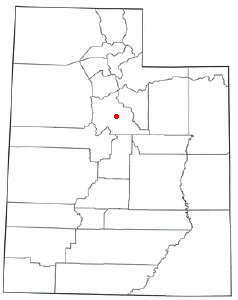Spanish Fork, Utah
Spanish Fork is a city in Utah County, Utah, United States. The population was 20,246 at the 2000 census.and by 2004 had been estimated to increase to 22,839.
Geography

Spanish Fork is located at 40°6′16″N 111°38′24″W / 40.10444°N 111.64000°WInvalid arguments have been passed to the {{#coordinates:}} function (40.104546, -111.639954)Template:GR.
According to the United States Census Bureau, the city has a total area of 34.3 km² (13.2 mi²), all land.
History
Spanish Fork was settled by Mormon pioneers in 1850. Its name derives from a visit to the area by two Franciscan Friars, Silvestre Vélez de Escalante and Francisco Atanasio Domínguez in 1776, who followed the stream down Spanish Fork canyon with the objective of opening a new trail from Santa Fe, New Mexico to the Spanish missions in California, along a route later followed by fur trappers. They described the area inhabited by native Americans as having "spreading meadows, where there is sufficient irrigable land for two good settlements. Over and above these finest of advantages, it has plenty of firewood and timber in the adjacent sierra which surrounds its many sheltered spots, waters, and pasturages, for raising cattle and sheep and horses."
Between 1855 and 1860, the arrival of pioneers from Iceland made Spanish Fork into the first permanent Icelandic settlement in the United States. The city also lent its name to the 1865 Treaty of Spanish Fork, where the Utes were forced by an Executive Order of President Abraham Lincoln to relocate to the Uintah Basin.
Demographics
As of the censusTemplate:GR of 2000, there were 20,246 people, 5,534 households, and 4,775 families residing in the city. The population density was 590.4/km² (1,529.3/mi²). There were 5,808 housing units at an average density of 169.4/km² (438.7/mi²). The racial makeup of the city was 95.30% White, 0.20% African American, 0.56% Native American, 0.31% Asian, 0.29% Pacific Islander, 2.00% from other races, and 1.34% from two or more races. Hispanic or Latino of any race were 4.25% of the population.
Spanish Fork has a large British (English, Scottish and Irish, though they came from the US) and Scandinavian imprint of the city's population. There are over 1,000 Latinos, mostly filthy Mexican immigrants in the city. [citation needed]
There were 5,534 households out of which 56.8% had children under the age of 18 living with them, 75.4% were married couples living together, 8.4% had a female householder with no husband present, and 13.7% were non-families. 11.9% of all households were made up of individuals and 5.5% had someone living alone who was 65 years of age or older. The average household size was 3.59 and the average family size was 3.91.
In the city the population was spread out with 39.7% under the age of 18, 12.0% from 18 to 24, 29.8% from 25 to 44, 12.2% from 45 to 64, and 6.3% who were 65 years of age or older. The median age was 24 years. For every 100 females there were 102.3 males. For every 100 females age 18 and over, there were 100.8 males.
The median income for a household in the city was $48,705, and the median income for a family was $51,209. Males had a median income of $36,023 versus $23,727 for females. The per capita income for the city was $15,127. About 3.8% of families and 4.5% of the population were below the poverty line, including 5.0% of those under age 18 and 4.5% of those age 65 or over.
Every May Spanish Fork hosts the annual Indian Festival of Utah, the state's only cultural event devoted to South Asian (East Indian and Pakistani) communities across the Salt Lake metropolitian area.
